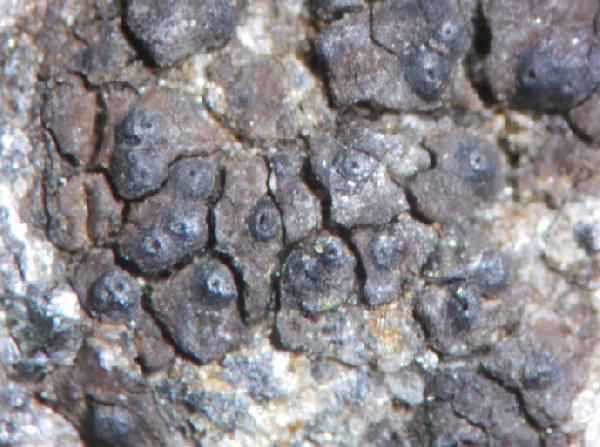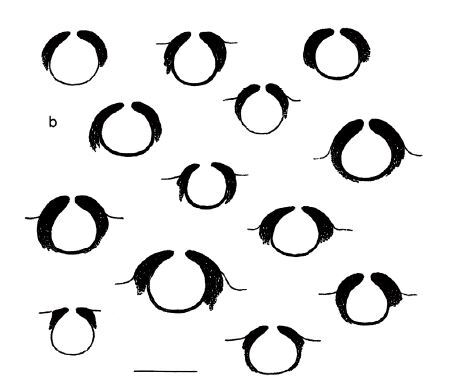Verrucaria poeltii (Servít) Breuss
Linzer biol. Beitr., 22: 721, 1990. Basionym: Involucrocarpon poeltii Servít in Poelt - Feddes Repert., 58: 168, 1955.
Synonyms:
Distribution: N - Frl (Breuss & Berger 2012).
Description: Thallus crustose, episubstratic, rimose-areolate, dark brown when dry, dark olive-brown when wet, 0.2-0.5 mm thick, sharply delimited, often with a black prothallus, forming 5-20 mm wide patches, the areoles 0.2-1 mm wide, polygonal with sharp angles, separated by thin fissures. Cortex 20-35 μm thick, of thick-walled cells with small lumina, without an epinecral layer; algal layer compact, 100-350 μm thick; medulla white, containing rock particles, often blackening near the perithecia, but without a black basal layer. Perithecia black, rather sparse, c. 20/cm², 1-3 per areole, ½–¾ immersed in the thallus, the upper part projecting, conical to hemispherical, 0.3-0.5 mm across, with a narrow ostiole (c. 0.1 mm). Involucrellum adpressed to exciple, reaching down ½-⅔ of the perithecium, 50-80(-100) μm thick in upper part, becoming progressively thinner downwards: exciple 0.25-0,4(-0.5) mm across, the wall 20-30 μm thick, at first colourless, then soon brown to black; hamathecium of 25-30 μm long periphyses and periphysoids, interascal filaments absent; hymenial gel hemiamyloid, I+ red (I+ blue at very low concentrations of I), K/I+ blue. Asci 8-spored, clavate, I-, fissitunicate, the wall thickened above, with an ocular chamber, dehiscent by extrusion of an endotunica to form a delicate rostrum, Verrucaria-type. Ascospores 1-celled, hyaline, broadly ellipsoid to globose, (9-)10-13(-14) x 7-9 μm. Pycnidia rare, fully immersed, with a colourless wall, 100-150 μm across. Conidia bacilliform, straight to slightly curved, 6-8 x c. 1 μm. Photobiont chlorococcoid. Spot tests: K-, C-, KC-, P-, UV-. Chemistry: without lichen substances.Note: on very compact calcareous rocks. The record is actually from Austrian territory, but very close to the border, and the species seems to be common and widespread in the Austrian Alps. For the differences with the very similar V. finitima and V. fischeri see Breuss & Berger (2012).
Growth form: Crustose
Substrata: rocks
Photobiont: green algae other than Trentepohlia
Reproductive strategy: mainly sexual
Commonnes-rarity: (info)
Alpine belt: very rare
Subalpine belt: very rare
Oromediterranean belt: absent
Montane belt: absent
Submediterranean belt: absent
Padanian area: absent
Humid submediterranean belt: absent
Humid mediterranean belt: absent
Dry mediterranean belt: absent

Predictive model
Herbarium samples
Growth form: Crustose
Substrata: rocks
Photobiont: green algae other than Trentepohlia
Reproductive strategy: mainly sexual
Commonnes-rarity: (info)
Alpine belt: very rare
Subalpine belt: very rare
Oromediterranean belt: absent
Montane belt: absent
Submediterranean belt: absent
Padanian area: absent
Humid submediterranean belt: absent
Humid mediterranean belt: absent
Dry mediterranean belt: absent

Predictive model
| Herbarium samples |
 INDEX FUNGORUM
INDEX FUNGORUM
 GBIF
GBIF
 DOLICHENS
DOLICHENS



